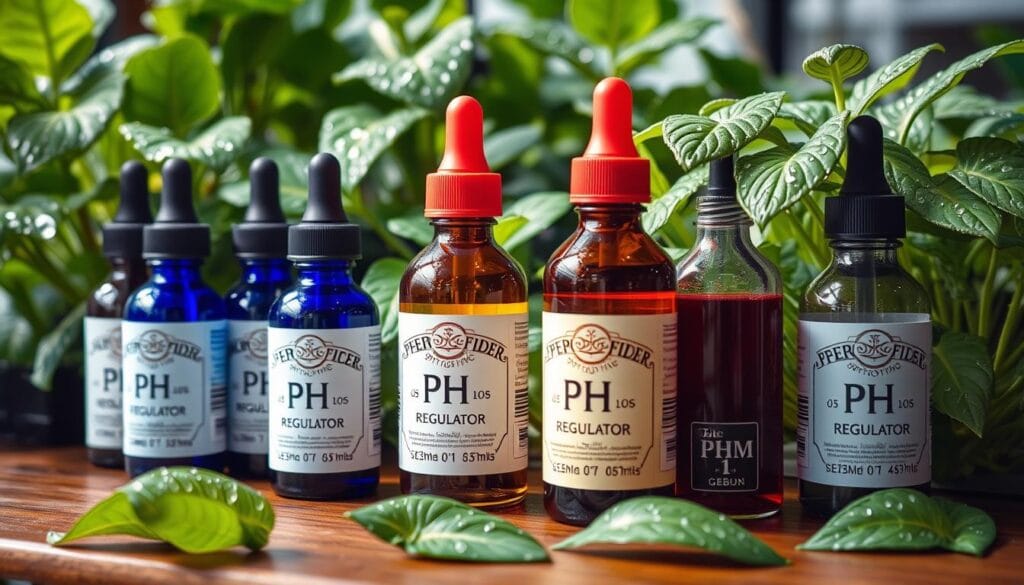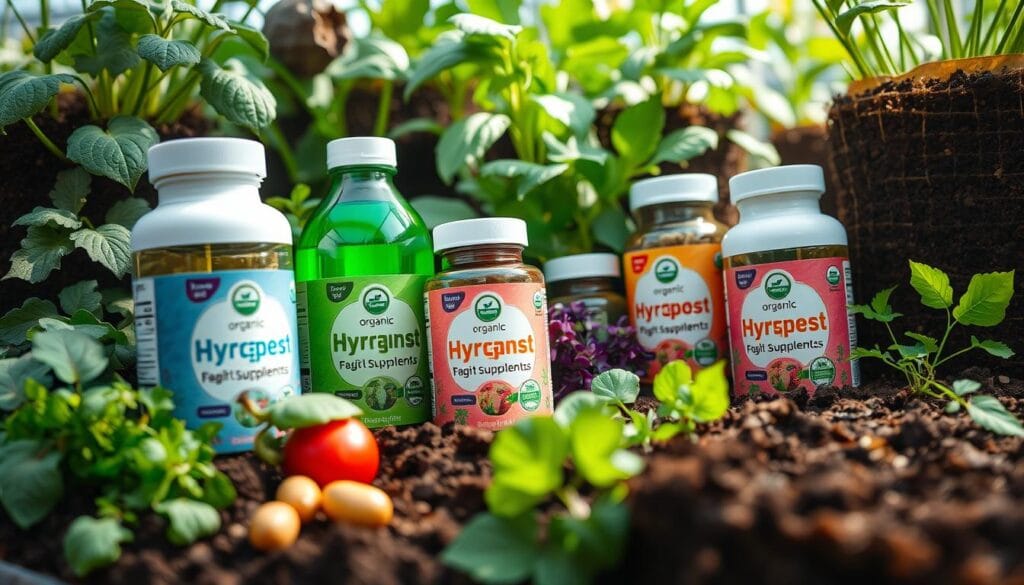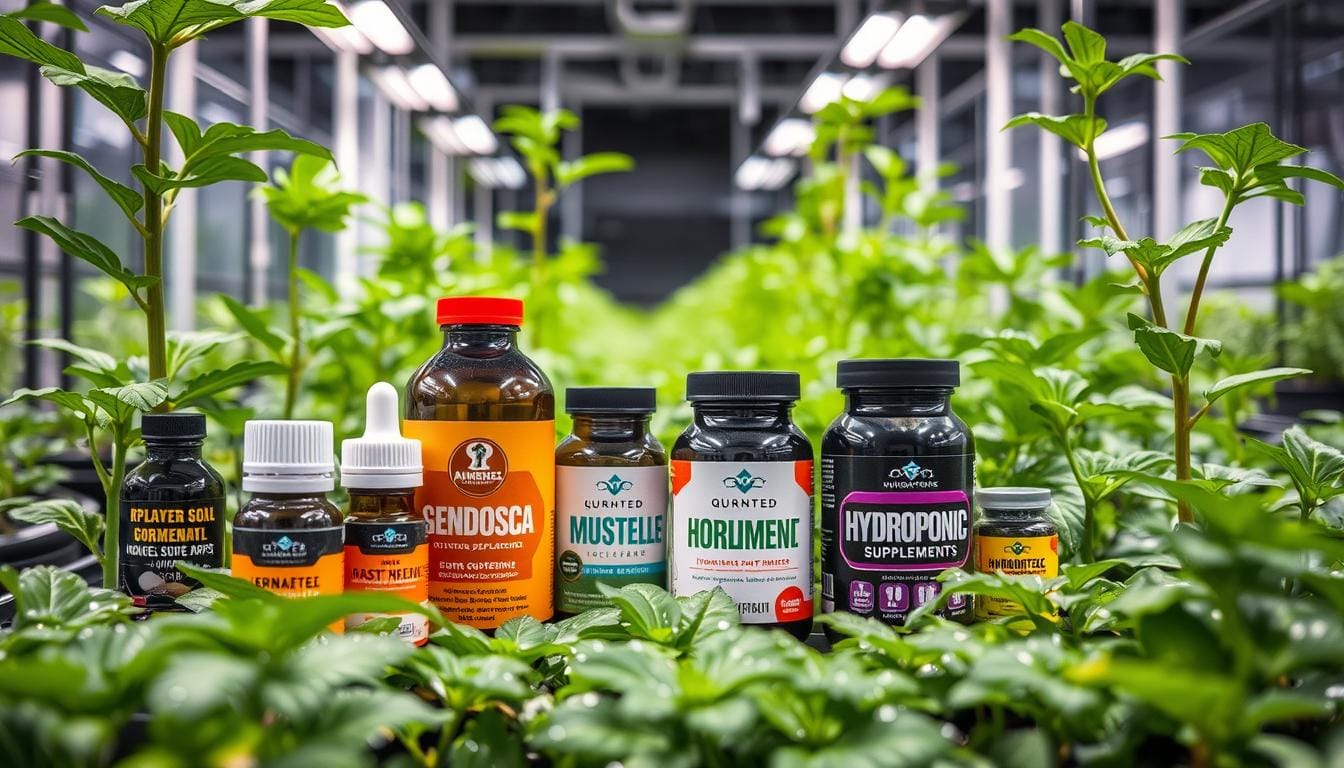As a passionate hydroponic gardener, I love seeing my plants grow and thrive. They reach new heights and give me plenty of harvests. But it’s not just luck – it’s about the right nutrients and supplements.
In this guide, we’ll look at the key supplements and hormones for a lush garden. Whether you’re new to hydroponics or experienced, knowing about plant nutrition is key. We’ll cover everything from macronutrients to micronutrients and how they help your plants.
Key Takeaways
- Macronutrients (N-P-K) are vital for key growth functions: nitrogen supports healthy foliage, phosphorus aids in strong root and flower development, and potassium enhances overall plant vitality.
- Micronutrients such as iron, zinc, and manganese are crucial for processes like photosynthesis, enzyme activation, and nutrient absorption.
- Optimal pH levels between 5.8 and 6.2 maximize nutrient absorption in hydroponic systems.
- Liquid and powder nutrient formulas benefit small and large-scale hydroponic setups.
- Organic and synthetic nutrient options each have advantages, with organic yielding higher antioxidant levels and synthetics providing precise ratios for rapid growth.
Understanding Hydroponic Supplements and Hormones
In hydroponic gardening, special supplements and hormones are key. They help plants grow well. These include plant growth regulators, hydroponic additives, and plant biostimulants. They affect how plants grow, from roots to flowers and fruits.
The Science Behind Plant Growth Regulators
Plant growth regulators, or phytohormones, control plant life. They are natural or made substances like auxins, cytokinins, and gibberellins. These substances help with cell growth, stem length, and root start. Knowing how they work is important for a good hydroponic setup.
Role of Hormones in Hydroponic Systems
Hormones in hydroponics send messages to plants. They start important growth times like germination and flowering. By carefully balancing these hormones, growers can enhance plant growth and boost yield.
Benefits of Supplemental Nutrition
Adding special nutrients to hydroponics has many benefits. These additives, like macronutrients and biostimulants, help plants grow faster and stronger. They also make plants more resistant to stress and improve the quality of what they produce.
- Promote faster growth rates and higher biomass production
- Improve nutrient uptake and utilization efficiency
- Enhance stress tolerance and resilience against environmental factors
- Stimulate the production of desirable compounds, such as essential oils or secondary metabolites
Understanding these supplements and hormones helps growers get the most from their hydroponics.
“The key to successful hydroponic gardening is optimizing the delicate balance of plant growth regulators and supplemental nutrients.”
Essential Macronutrients for Hydroponic Success
Hydroponic gardening thrives with the right macronutrients. Nitrogen (N), phosphorus (P), and potassium (K) are essential for plant health and growth. They fuel plant growth and development.
Nitrogen makes plants grow green and leafy. Phosphorus promotes strong root development and encourages the blooming of flowers. Potassium makes cells strong and plants healthy.
| Macronutrient | Role in Plant Growth |
|---|---|
| Nitrogen (N) | Fuels leafy growth and green coloring |
| Phosphorus (P) | Supports flower production and root development |
| Potassium (K) | Strengthens cell walls and boosts plant vigor |
Adjust the N-P-K ratio in your hydroponic fertilizers for best growth. Use a 3-1-2 ratio for vegetative growth. Switch to a 1-3-2 ratio for flowering.
By adjusting macronutrients and their N-P-K ratio, your hydroponic system will thrive. Enjoy lush growth and plenty of harvests.
Micronutrients: Critical Components for Plant Health
Macronutrients such as nitrogen, phosphorus, and potassium are vital for healthy plant growth. But, micronutrients like iron, zinc, and manganese are just as important. They power your hydroponic plants from the inside out.
Trace Elements and Their Functions
Iron helps make chlorophyll, which is vital for photosynthesis. Zinc is important for growth hormones. Manganese supports photosynthesis, copper helps enzymes, and molybdenum fixes nitrogen. Each micronutrient has a unique role in your hydroponic garden.
Signs of Micronutrient Deficiencies
Deficiencies in micronutrients show up in different ways. Iron deficiency makes leaves yellow between the veins. A zinc deficiency can lead to distorted and stunted plant growth. Manganese deficiency leads to yellowing between the veins.
Watching your plants closely helps you spot and fix these problems early.
Supplementation Strategies
To make sure your plants get all the micronutrients they need, keep the pH between 5.8 and 6.2. This pH range helps trace elements work better. Also, using chelated micronutrients is a good idea. They are stable and release nutrients slowly, helping your plants absorb them better.
“Chelated micronutrients enhance plant growth and crop yields by offering essential minerals in a more readily absorbed form.”
By watching for specific symptoms and adjusting your nutrient solutions, you can help your hydroponic crops grow well. They will get the micronutrients they need to reach their full potential.
Plant Growth Hormones for Enhanced Development
In hydroponic gardening, plant growth hormones are key to better plant growth and performance. These chemicals, or plant growth regulators (PGRs), control important processes like stem growth, root start, and fruit ripening. By using these hormones, growers can control plant growth, improve stress resistance, and boost crop quality.
The five primary types of plant growth hormones are auxin, gibberellin (GA), cytokinin, ethylene, and abscisic acid (ABA). Each hormone has its role in plant growth:
- Auxin, like indoleacetic acid (IAA), helps with stem growth, rooting, and leaf fall.
- Gibberellins, such as gibberellic acid (GA), promote cell growth, break dormancy, and speed up germination.
- Cytokinins help cells divide and are used in tissue culture to grow shoots or roots.
- Ethylene helps fruits ripen and causes leaves and fruits to fall off.
- Abscisic acid (ABA) slows growth, stops seeds from germinating, causes leaves to fall, and closes stomata.
Using these hormones in hydroponics can greatly affect plant growth. For instance, auxin-based hormones can help roots grow. Gibberellins can wake seeds from sleep and speed up germination. Ethylene can make fruits ripen faster and look better.
| Plant Hormone | Concentration Range | Key Functions |
|---|---|---|
| Auxin (IAA) | 0.1-10 ppm | Apical dominance, rooting, leaf abscission |
| Gibberellin (GA) | 0.1-10 ppm | Cell division and elongation, dormancy breaking, germination |
| Cytokinin | 0.1-10 ppm | Cell division, shoot and root growth |
| Ethylene | 0.1-10 ppb | Ripening, abscission, senescence |
| Abscisic Acid (ABA) | 0.1-10 ppm | Dormancy, abscission, stomatal closure |
By managing these hormones well, hydroponic growers can improve plant growth, stress tolerance, and crop quality. Knowing how each hormone works and at what levels is key to success in hydroponics.
Rooting Hormones and Cloning Solutions
Rooting hormones are key for growing plants from cuttings. They help roots grow faster and stronger. Compounds like indole-3-butyric acid (IBA) and naphthaleneacetic acid (NAA) boost your cloning success.
Types of Rooting Compounds
Rooting hormones come in powders, gels, and liquids. They fit different plants and methods. Hormex has powders for soft to hard cuttings, helping your plants thrive.
Application Methods and Timing
Using rooting hormones right is important. Powders are easy, gels stick well, and liquids are precise. Apply them immediately after cutting for best results.
Success Rates and Best Practices
Choose the right hormone and method for high success. Clonex Rooting Gel is almost perfect, and Garden Safe TakeRoot is affordable. Follow the instructions and keep conditions right for your cuttings.
Rooting hormones are essential for gardeners and growers. They make plant propagation easier. Knowing how to use them can lead to a successful harvest of healthy plants.
pH Regulators and Buffer Solutions
Keeping the right pH is key for your hydroponic system’s best performance. Most plants thrive in a pH range of 5.8 to 6.2. This range helps them absorb nutrients well. It’s important to check your nutrient solution’s pH every day with a good pH meter.
If the pH gets too high or too low, you’ll need to adjust it. Use pH regulators, special hydroponic additives, to slowly change the pH. When adjusting, add just 1 ml per gallon of solution. Wait 15-20 minutes before adding more to let it mix well.
Buffer solutions can also help keep your system’s pH stable. They resist pH changes, keeping it steady. This is great for systems with lots of nutrients or water with extreme pH levels.

By watching and adjusting the pH with pH regulators and buffer solutions, you create a perfect growing spot. Your plants will get all the nutrients they need. This results in healthier plants and improved yields.
Bloom Boosters and Flowering Enhancers
Hydroponic gardeners looking to boost their plants’ blooms can use bloom boosters and flowering enhancers. These supplements are made to give plants the nutrients and hormones they need for big, beautiful blooms.
Timing of Application
Using bloom boosters and flowering enhancers right is key. They’re best applied when plants start flowering and continue through the blooming phase. This timing ensures plants get the nutrients and growth regulators they need for the best blooms.
Concentration Guidelines
It’s crucial to follow the recommended concentrations when using these products. They’re very concentrated, so start with half-strength and increase as needed. Watching how your plants react will help you find the perfect amount for your setup.
Expected Results
Using bloom boosters and flowering enhancers can bring many benefits, including:
- Increased flower set for more blooms
- Larger, more vibrant flowers that stand out
- Potential for higher yields from better flowering
Adding these hydroponic supplements to your routine can give your plants the support they need to bloom well.
Nutrient Solution Management
Proper nutrient solution management is key to a thriving hydroponic system. Keeping the right nutrient levels and environment is crucial for your plants to grow well. Let’s explore the important parts of effective nutrient solution management.
First, keep your nutrient solution’s temperature between 65-75°F. This range optimizes nutrient absorption for your plants. If the temperature goes out of this range, it can harm plant growth and cause nutrient shortages.
Next, adjust the nutrient solution’s electrical conductivity (EC) based on your plants’ growth stage. Fruit plants need a higher EC of 2.0-4.0 mS/cm, while leafy greens do better with 1.2-1.8 mS/cm. Regularly checking and adjusting the EC ensures your plants get the right mix of nutrient solutions and hydroponic fertilizers for strong nutrient management.
| Plant Type | Ideal EC Range (mS/cm) |
|---|---|
| Fruiting Plants | 2.0 – 4.0 |
| Leafy Greens | 1.2 – 1.8 |
To avoid salt buildup and keep nutrients balanced, flush your hydroponic system every 2-6 weeks. This simple step keeps your nutrient solutions clean and your plants healthy.
By watching your nutrient solution’s temperature, EC, and flushing the system often, you ensure your plants get the best hydroponic fertilizers and nutrient management. Good solution management is essential for a successful hydroponic setup.
Organic vs Synthetic Supplements
In hydroponic gardening, the debate between organic and synthetic nutrients is ongoing. Both offer distinct benefits and come with factors to consider. Gardeners need to think carefully about what’s best for them.
Comparing Effectiveness
Organic hydroponic supplements lead to crops with 15-20% more antioxidants and better pest resistance. But, synthetic nutrients give plants a precise mix of nutrients. This can lead to faster growth and yields up to 25% higher than organic methods.
Environmental Impact
Organic nutrients are better for the environment because they come from natural sources. In contrast, synthetic hydroponic fertilizers have a bigger environmental impact. They need chemical production and can harm ecosystems if not used right.
Cost Considerations
Organic nutrients are typically more affordable, making them an ideal option for budget-conscious gardeners. Synthetic nutrients, however, can offer higher yields. This might make up for the higher initial cost over time.
Some growers mix both organic and synthetic nutrients. They use synthetic during growth and switch to organic 2-3 weeks before harvest. This boosts flavor and nutrient density.
“Maintaining pH levels between 5.8 and 6.2 is essential for ensuring optimal nutrient availability in hydroponic systems.”
The choice between organic and synthetic supplements depends on your goals, budget, and priorities. Knowing the pros and cons of each helps you make the best choice for your hydroponic garden.

Prevention and Treatment of Nutrient Deficiencies
Keeping your hydroponic plants healthy is key. Spotting nutrient deficiencies early is vital. Yellow leaves might mean you need more nitrogen. Purple leaves could be a sign of phosphorus issues. Brown edges on leaves often point to a potassium problem.
To fix these issues, tweak your nutrient mix. Make sure your system’s pH is between 5.8-6.2. This helps plants absorb nutrients better. Regular checks and quick action can prevent many problems.
| Nutrient Deficiency | Visual Symptoms | Recommended Action |
|---|---|---|
| Nitrogen (N) | Yellowing of leaves, stunted growth | Increase nitrogen levels in the nutrient solution |
| Phosphorus (P) | Purple or reddish discoloration of leaves | Increase phosphorus levels in the nutrient solution |
| Potassium (K) | Brown or scorched leaf edges | Increase potassium levels in the nutrient solution |
Fixing nutrient issues is essential for healthy plants. Keep an eye on your plants and adjust the nutrients as needed. This way, your hydroponic plants will flourish and grow well.
Monitoring and Maintenance Protocols
Keeping your hydroponic system healthy is key for your plants to thrive. Set up a detailed monitoring and maintenance plan. This ensures your plants get the right nutrients and conditions to grow well.
Begin by consistently monitoring the pH and electrical conductivity (EC) of your nutrient solution. Aim for daily checks. Accurate pH and EC levels help plants absorb nutrients better and stay healthy. Keep a log of these measurements and any changes you make.
- Do weekly visual checks on your plants for signs of nutrient problems, pests, or other issues.
- Record all nutrient additions, including type, amount, and when you add them.
- Regularly clean and sanitize your hydroponic gear, like reservoirs and tubing, to stop pathogens and algae.
As your plants grow, adjust the lighting, temperature, and humidity to meet their needs. By monitoring plant health and keeping your hydroponic system in good shape, you ensure your plants get the best nutrition and environment for growth and productivity.
| Maintenance Task | Frequency | Purpose |
|---|---|---|
| pH and EC Checks | Daily | Ensure Proper Nutrient Uptake |
| Visual Plant Inspections | Weekly | Identify Issues Early |
| Equipment Cleaning and Sanitization | Regular | Prevent Pathogen Buildup |
| Lighting and Environment Adjustments | As Needed | Support Plant Growth Stages |
“Regular monitoring and proactive maintenance are essential for ensuring optimal plant health and maximizing productivity in any hydroponic system.”
Conclusion
Learning how to use hydroponic supplements and hormones is key to growing great plants. You need to balance nutrients and keep the right pH and electrical conductivity. This way, your hydroponic garden will flourish.
Knowing how to use these supplements and hormones is vital. It helps you understand how they help plants grow. Whether you’re new or experienced, staying current with new research will help you grow healthy plants.
Keep paying attention to your garden and be ready to make changes. This is how you get the most out of your hydroponic system. By following the tips in this article, you’ll have a garden that’s not just productive but also beautiful.

